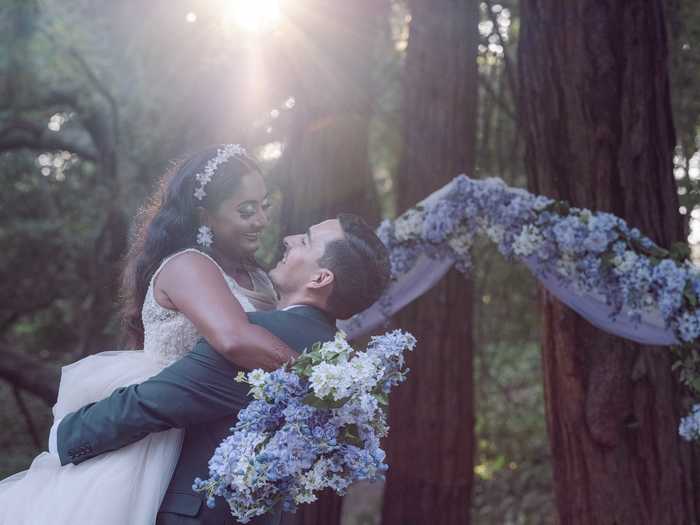A bride ditched tradition and wore secondhand outfits for her sustainable Hindu-Christian wedding
Pavan Mahal

- Nivi Achanta and Ben Mallory got married on August 25, 2023.
- Achanta told Insider she struggled to plan a sustainable wedding while honoring Indian customs.
Sustainability was a big part of Nivi Achanta and Ben Mallory's relationship from the start.
Achanta and Mallory met through mutual friends in 2016 while they were attending UC Davis. They officially started dating in 2018, and were together for five years before getting engaged in July.
In college, they both made a conscious effort to adopt sustainable habits, whether that was biking to campus, buying produce from farmers markets, or working toward being zero-waste. Today, Achanta works as founder of the Soapbox Project, which provides "bite-sized action plans" to help people take steps toward a more sustainable lifestyle, according to the website.
So it's no surprise that sustainability was a big priority for Achanta and Mallory when it came to wedding planning. From secondhand outfits to rent-and-return florals, the couple set out to minimize waste, travel, and costs — and make mindful choices that felt special to them as a couple.
Ben Mallory proposed to Nivi Achanta with a new bike in July of this year.

At the start of 2022, the couple agreed that Mallory, who is currently pursuing his doctoral degree, wouldn't propose to Achanta with a traditional engagement ring.
"Nivi can be prone to misplacing things, especially smaller items like rings, so spending a large amount of money on something that might get 'permanently misplaced' was a leading factor in our deviation from a wedding ring," Mallory told Insider.
He added: "If I was going to spend a good chunk of money on something for our engagement, I wanted it to be an investment in our relationship and something that would bring us closer together."
Achanta said she also started thinking critically about weddings, particularly how customs like getting a ring are systemic rather than individual choices.
"We have invented a lot of the cultural concepts within the past 200 years, like how the diamond industry marketed diamonds as engagement rings," she said, referencing the De Beers marketing campaign that popularized its diamonds for engagement rings. Decades later, diamonds continue to reign supreme as the stone of choice for engagement rings, with it being the top choice for 85% of ring shoppers in 2021, according to The Knot.
Since biking has always been a big part of their relationship, Mallory decided it made more sense to buy Achanta new wheels rather than an expensive ring.
However, Achanta said they did still mark their engagement with a "cheap, fashion jewelry ring" — a moissanite option from a local Asian-owned company called DovEggs — that Mallory chose after the proposal.
"I wouldn't have to worry about if I lost it, both cost-wise and because it doesn't carry that much importance to us," Achanta said. "The bike is the star of the show."
When it came to wedding planning, Achanta and Mallory knew they wanted to celebrate sustainably.

Sustainability is important to Achanta, but she said she also thinks people should be able to do things that bring them joy. Achanta, however, wanted her wedding to be helpful rather than harmful, so she focused on planning "mindfully sustainable" events.
She said she thought a lot about a video from The Story of Stuff, which visualizes humanity's current rate of consumption and concludes that we will need five planet Earths to hold the "stuff" being consumed.
"Weddings for me are supposed to be the 'happiest day of your life', and I don't want to associate that with doing harm to the planet that I love living on," Achanta said. "I just see no reason to have a very wasteful wedding."
Mallory, who was equally as excited about planning their sustainable wedding, said the choices they made allowed them to create their own traditions.
"It has been an awesome experience getting to work with individuals and companies that also care about sustainability," he said. "It has given a purpose and meaning behind every item and activity we have, which makes everything feel more special."
The couple planned to have a Hindu-Christian celebration, with their wedding events spread out over a weekend in August.

The couple wanted to have events that represented both of them. Their wedding weekend kicked off on August 25 with a welcome dinner for their guests in the style of a game night, catered with pizzas from a local business.
This was followed by their Hindu wedding ceremony and sangeet, a traditional event in Indian weddings that involves singing and dancing. The wedding festivities concluded with a Christian ceremony held in a church in a local community hall and a karaoke reception.
The couple struggled with honoring some of the more extravagant Indian wedding traditions, which Achanta said are part of a bigger problem.

Achanta thinks the emphasis on collectivism in South Asian and, more specifically, Indian communities has hugely influenced the continuation of the "big fat Indian wedding."
She said it's a culture of comparison that has pushed families like hers to have big weddings because of the statement it makes in their community. She added that social media trends and economic privilege have had a part to play in creating this culture, where the people consuming the most have the most resources, creating a discrepancy in the quality of South Asian weddings and heightening feelings of comparison.
Instead of conforming to these ideals, Achanta wanted to make purchases and create traditions that were meaningful to her, as well as mindfully sustainable — but her grandma didn't always agree with the couple's choices, she said.
For instance, her grandma was expecting a larger guest list — Indian weddings typically have guest lists of around 400 people. But Achanta and Mallory scaled down their invites to 150 people.
"I would love to throw a party for 150 people to celebrate us and everybody has a good time, and I think that's the core of what it is supposed to be about," she told Insider before the wedding.
Achanta's grandma was also unsure about the decision to cut the Hindu wedding ceremony time down to an hour and a half. Typically, Achanta said, it would be over four hours. This meant the length of certain rituals within the ceremony would inevitably be shortened.
"I think she'd be mad if I called this 'traditional,'" Achanta said of her ceremony.
"I didn't want to sit through hours and hours of a ceremony," she added. "In my family, the wedding ceremony itself can be even seven hours long."
Sustainable outfits were important to the couple — even if it meant breaking tradition.

Achanta said South Asian weddings can sometimes feature up to three outfits in a day — two for the ceremony itself, and another for the reception — and they're typically always new garments.
But Achanta only wore one outfit for her Hindu wedding ceremony, breaking from Telugu tradition.
"In the middle of the Telugu ceremony, you have one outfit when you're entering, and then you change into white," Achanta explained.
"I don't unnecessarily want to get a bunch of outfits that I'm never going to wear again," she said of her decision to only wear one look, adding that it was another one of the "points of contention" with her family.
It was, however, the only event where Achanta wore something new. Her mom bought her a bright-pink silk sari from India, which was within the $250 budget Achanta gave her beforehand.
Achanta said there's a stigma around used clothing at Indian weddings. Despite that, she really wanted to buy secondhand fashion for her nuptials.

Indian party and bridalwear is typically bought through vendors in India, where items are custom-made. Buying these items secondhand would help to minimize both carbon emissions and the habitual disposal of Indian clothes as fashion changes.
"I don't want to associate my wedding with doing harm to the planet I love, specifically in the case of fashion," Achanta said. "I don't want to be further responsible for exploitation and the exploits of labor practices that come with that."
But as a Brahmin — deemed the highest of the Hindu caste system in India — Achanta was raised to believe there is a strong disdain for things that appear contaminated because it deters from welcoming good energy.
"That translates into having new stuff," Achanta said, meaning buying secondhand would have been seen as dirty.
She added: "I never started thrifting until college — when I started thinking through these beliefs for myself."
It was important to Achanta to buy secondhand outfits for the rest of her wedding events. For her welcome dinner, she wore a bright-teal lehenga with sparkly tasselling at the waist. She said she purchased it for $175 from a buy-and-sell group on Facebook and spent an extra $100 on tailoring.
Meanwhile, for their sangeet, she wore another secondhand lehenga from the same Facebook group. The fully sequined piece — which had a navy-blue blouse and a vibrant, multicolored skirt — cost her $125, including the $20 she spent for hemming.
Indian fashion rental startups have never really taken off, adding to the problem.

While the market has made itself known in recent years, not all startups have been able to gain momentum — and a lot of the options are for wedding guests rather than brides.
"It sounds like a very obvious fix of, 'So many of us have clothes. Let's build a marketplace — we'll solve it,'" Achanta said. "But it goes a lot deeper than that."
"There are so many South Asian people waiting for businesses that understand the problem, instead of entrepreneurs that say they can fix this problem with tech-driven solutions," she added.
Achanta said another issue is the lack of incentive to buy secondhand Indian fashion, as the costs of buying something used are often similar to buying new. She said she posted about the issue of "negligible markdowns" in the buy-and-sell Facebook group that she had been buying most of her wedding outfits from.
"I don't really know what the solution is," her post reads. "I think we have to think of Indian clothes in a similar way as driving a new car off the lot and depreciating maybe 50% after the first wear."
Initially, listings in the group hardly had any markdowns, which Achanta said blew her mind.
"These are outfits that you're wearing when around smoke and fire," she said, referring to the holy fires of Hindu wedding ceremonies. "And you're dancing around and sweating in them."
"In my opinion, when you post a secondhand outfit, you should mark it down by half because you're not going to wear it again, and the other person probably has to make further alterations to it," Achanta said.
She said her post garnered a lot of support among the group's 6,000 members, with many voicing their agreement.
Achanta said it was easier to buy a white bridal dress secondhand than an Indian bridal outfit.

Achanta said she felt confident browsing for white wedding dresses because of the high number of options to choose from.
"There are at least 10 different marketplaces where you can get affordable, good condition, verified white wedding dresses," she said. In the end, Achanta found hers for $500 on Facebook Marketplace. She said alterations cost more than the dress itself.
She had shortlisted three dresses on Marketplace and made the trip to try each one on.
"The sustainability route for a white or Christian wedding is honestly painless," she said. "I feel more optimistic for people not doing a multicultural wedding because there's just so many options."
When browsing for Indian clothing, Achanta found a lot of what was available was limited in choice and to certain areas, like New Jersey, which has a larger Indian community than where she lives on the West Coast.
"I'm only 5 feet tall, so a lot of outfits are too big for me or they're also all made to measure, so I would have to fit all the dimensions," she said. "I didn't want to blindly just have someone ship an outfit from the East Coast without trying it on."
She said her final Indian outfits came together by luck, but she doesn't feel hopeful for future Indian women searching for secondhand clothing given the lack of options.
The outfits weren't the only sustainable aspect of the couple's wedding, though. They also chose their venues with waste management in mind.

Two of the venues the couple chose were community centers and halls in the Bay Area.
"I love community centers and want them to be more well-funded," Achanta said.
"And because they are owned by the local government, all information is very transparent on their website," she added, referring specifically to composting and waste disposal.
Couples have to bring in their own reusable plates and cutlery or make sure that they are compostable, which the venues' composting facilities accommodate.
However, some mindfully sustainable choices were limited by budget.

There were certain things Achanta wished the couple could have afforded but ultimately had to sacrifice — including choices around sustainable food and catering.
"A lot of [caterers] that count their sustainability credentials are farm-to-table restaurants that are really gorgeous," Achanta said, "but we're not doing that because of budget."
One of those caterers included a taco vendor, who they chose because of affordability.
"I don't know if they have sustainably sourced chicken or not," she added, because it's not flagged in their credentials, "but I'm an entrepreneur and [Ben] is a Ph.D. student. So we are working with a lot of constraints."
Balancing budget with sustainability and her family dynamics meant Achanta had to tell herself, "We can't have everything," and think more about the compromises she was willing and unwilling to make to help her work through the planning.
Achanta aimed to limit food waste as much as she could.

Achanta said they provided to-go boxes and asked guests to take food with them at each event over their wedding weekend.
"Last September, when my best friend got married, I was in charge of bugging every single person to take boxes of food home with them," Achanta said.
"I made the DJ take home 3 tupperwares of food!" she said, meaning that they only had one tray of food left over, as opposed to what was initially 10 before leftovers were given out.
One of the couple's venues was also next to a women's shelter, which they worked with to donate the rest of the uneaten food.
"I just think it's unconscionable to waste food, where so many people don't have enough to eat," Achanta said, calling it the most frustrating part of planning the wedding.
A more mindful choice for their wedding florals was a no-brainer.

Something Borrowed Blooms, a rent-and-return flower business specializing in silk florals, worked with the couple to provide decorations for the wedding. The company says fresh wedding flowers alone contribute to approximately 4 billion tons of waste each year.
"Every single person has a huge opportunity to sit and think for 15 minutes about different options that they have for any event, whether it's a wedding, or baby shower, or birthday party, and think if you want to contribute to the problem or the solution," Achanta said.
The couple said they were thrilled to work with the floral company because of their aligned values on affordability and sustainability. According to the company's website, it rents out each of its silk flower arrangements an average of 26 times per year.
"It's awesome seeing that there are companies that can do this sort of thing at scale, and even if we didn't have the partnership with them, it would still be so much more affordable," Achanta said.
Achanta is optimistic about a future with more sustainable Indian weddings.

After messaging in the buy-and-sell Facebook Group, Achanta said a wave of other brides started posting about wanting to plan their weddings in a mindfully sustainable way.
This, along with the release of the Netflix show "The Big Day," which highlighted 12 South Asian weddings across the spectrum, gave her great hope for the cause.
One couple on the show planned an entirely sustainable wedding, which Achanta said she admired.
Exposure of this issue to a mass audience on Netflix, coupled with her own experience, made Achanta feel that enough people are thinking about wanting to be more sustainable, but they might not have the courage or language to advocate for it in their own families.
"If your whole family would look down on you for wanting to do something sustainable — kind of how I'm experiencing — some people have a lot more to lose," she said.
On the flip side, Achanta said she felt confident bringing up these conversations with her family, and she doesn't think she's the only one beginning to do this.
"I think that more people are starting to feel like it's low stakes and can start these conversations," she said.
When it comes to Indian — and broader South Asian — families planning more sustainable weddings, she does think "a tipping point is totally possible."
"It's just about having people take those first steps on behalf of other South Asians," she said, "specifically women that are thinking about the same things."
Popular Right Now
Popular Keywords
Advertisement